Volume 28.1
January–April 2025
Full table of contents
ISSN: 1094-8074, web version;
1935-3952, print version
Recent Research Articles
See all articles in 28.1 January-April 2025
See all articles in 27.3 September-December 2024
See all articles in 27.2 May-August 2024
See all articles in 27.1 January-April 2024
Article Search
FIGURE 1. Map with fossil sites which are currently included in the database. The numbers indicate the sites, as provided in the leftmost column in Table 1.
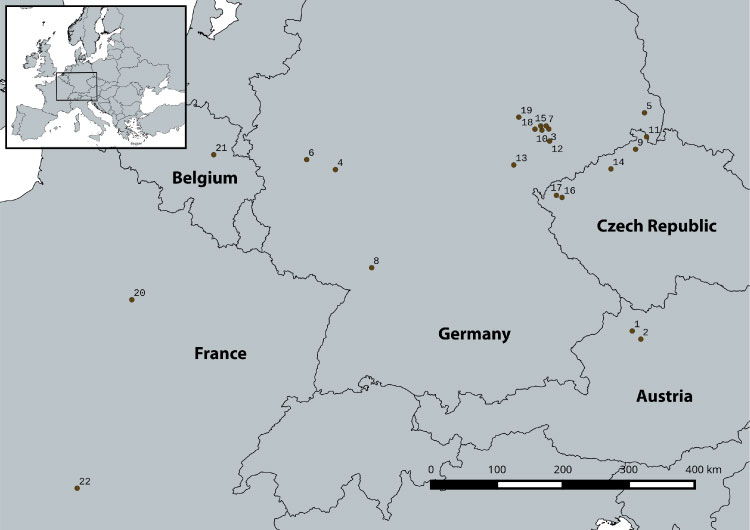
FIGURE 2. Example for the process of producing shapefiles from fossil leaf images. Green line: outline of original fossil. Red line: outline of replenished leaf. The red line partially covers the green line. Blue lines: petiole length and petiole width at the most apical point of the petiole. Yellow rectangle: bounding box encasing the specimen. Craspedodromophyllum betuloides Kvaček and Teodoridis, 2011 (NMP_G11231, Prague).
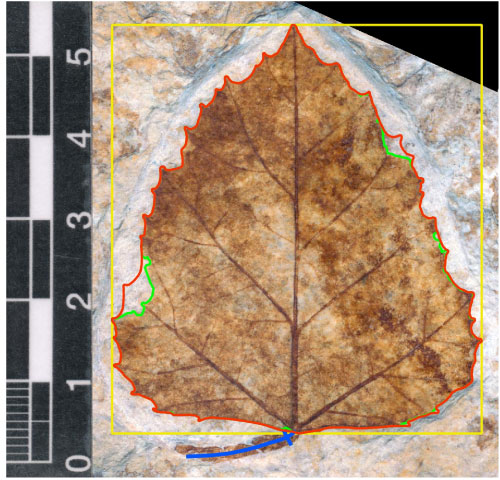
FIGURE 3. Frequency of toothed and untoothed leaf margins for the Paleocene, Eocene and Oligocene, obtained for 3214 specimens in MORPHYLL. Significance level (Pearson Chi-Square) < 0.001.
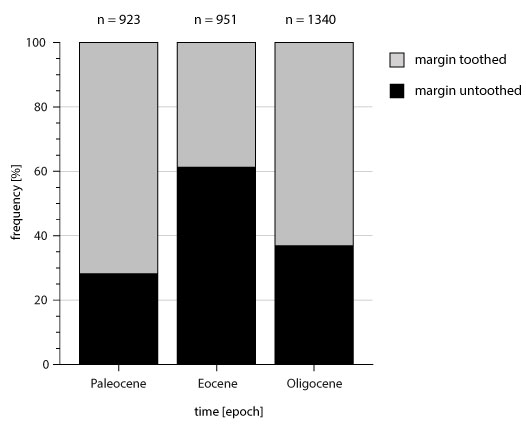
FIGURE 4. Data distribution of leaf lamina area (1), leaf circularity (2) and leaf mass per area (LMA) (3) for the Paleocene (blue graphs and box plots), Eocene (green graphs and box plots), Oligocene (red graphs and box plots) and all data (black graphs and box plots). The box plots span the 50 % interquartile. The lines within the boxes indicate the median values. The “whiskers” mark the highest and lowest values. Outliers are drawn as filled circles.
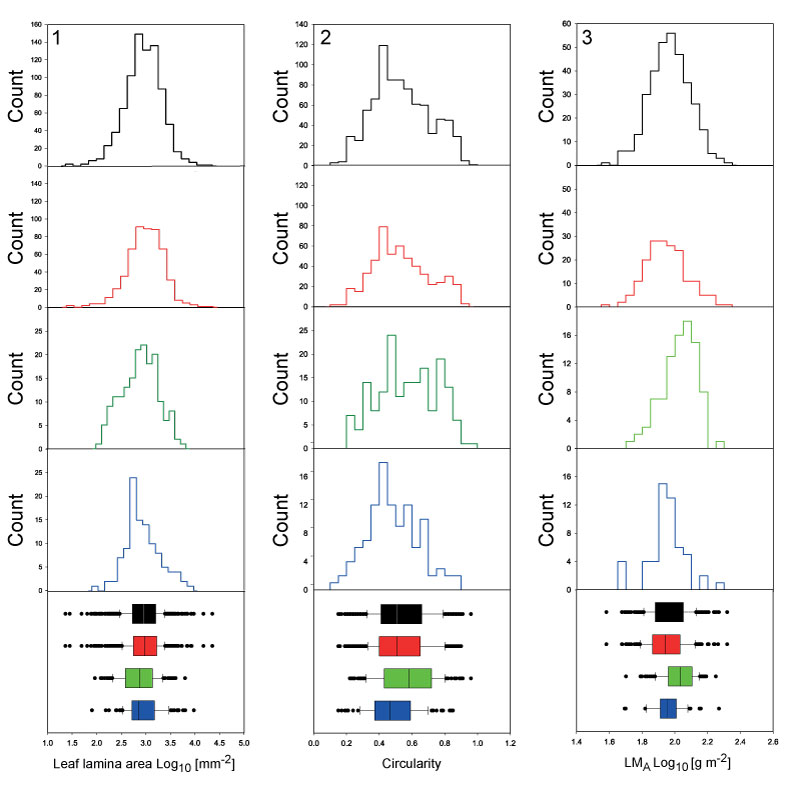
FIGURE 5. Random sampling analysis for LMA, for evaluation of the number of data required to arrive at a statistically stable signal. (1) Three independent rounds (blue, green and red) of drawing 15 random samples from specimens of one taxon (Platanus neptuni), site Rauenberg (Oligocene). The grey horizontal line represents the mean value for all specimens of P. neptuni from Rauenberg. The graphs show the LMA value of each random sample. (2) The course of the mean value of LMA , calculated after each drawing cycle. (3) Three independent rounds (blue, green and red) of drawing 30 random samples from all specimens from the site Kučlín (Eocene). The grey horizontal line represents the mean value for all specimens. The graphs show the LMA value of each random sample. (4) The course of the mean value of LMA, calculated after each drawing cycle.
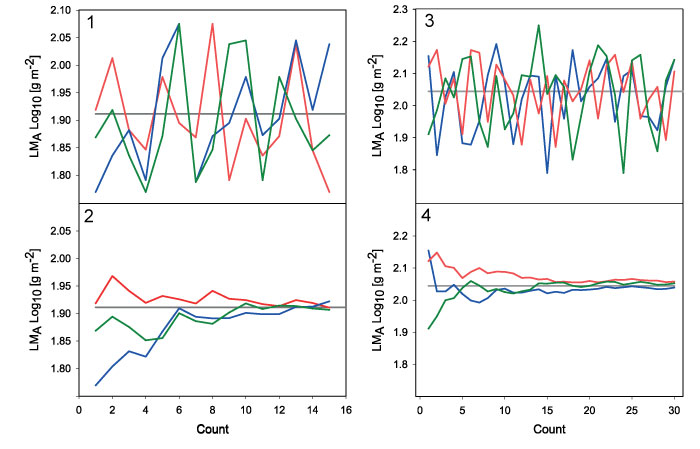
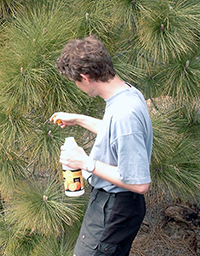 Christopher Traiser. State Museum of Natural History, Rosenstein 1, 70191 Stuttgart, Germany. traiser@smns-bw.de
Christopher Traiser. State Museum of Natural History, Rosenstein 1, 70191 Stuttgart, Germany. traiser@smns-bw.de
Christopher Traiser studied biology, geology and meteorology and received his PhD in palaeontology at the University of Tübingen. He has his main research interests in the evolution of plant leaves in space and time and its relationship to palaeoenvironmental conditions.

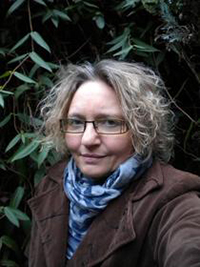 Anita Roth-Nebelsick. State Museum of Natural History, Rosenstein 1, 70191 Stuttgart, Germany. anita.rothnebelsick@smns-bw.de
Anita Roth-Nebelsick. State Museum of Natural History, Rosenstein 1, 70191 Stuttgart, Germany. anita.rothnebelsick@smns-bw.de
Anita Roth-Nebelsick is curator for fossil plants at the State Museum of Natural History in Stuttgart. Her research interests focus on plant functional morphology and palaeoecology.

 Michaela Grein. State Museum of Natural History, Rosenstein 1, 70191 Stuttgart, Germany. michaela.grein@smns-bw.de; present address: Übersee-Museum Bremen, Bahnhofsplatz 13, 28195 Bremen, Germany. m.grein@uebersee-museum.de
Michaela Grein. State Museum of Natural History, Rosenstein 1, 70191 Stuttgart, Germany. michaela.grein@smns-bw.de; present address: Übersee-Museum Bremen, Bahnhofsplatz 13, 28195 Bremen, Germany. m.grein@uebersee-museum.de
Michaela Grein received her PhD in paleontology from the University of Tübingen, Germany. She is a research associate in paleobotany at the State Museum of Natural History in Stuttgart. Her research is focused on paleoclimate and paleoCO2-modeling, and the paleoecological analysis of Cenozoic leaf floras.

 Johanna Kovar-Eder. State Museum of Natural History, Rosenstein 1, 70191 Stuttgart, Germany. johanna.eder@smns-bw.de
Johanna Kovar-Eder. State Museum of Natural History, Rosenstein 1, 70191 Stuttgart, Germany. johanna.eder@smns-bw.de
Johanna Kovar-Eder´s research is focused on leaf assemblages and the evolution of flora and vegetation in the Paleogene and Neogene.

 Lutz Kunzmann, Senckenberg Natural History Collections Dresden, Königsbrücker Landstr. 159, 01109 Dresden, Germany. lutz.kunzmann@senckenberg.de
Lutz Kunzmann, Senckenberg Natural History Collections Dresden, Königsbrücker Landstr. 159, 01109 Dresden, Germany. lutz.kunzmann@senckenberg.de
Lutz Kunzmann got a PhD in paleontology/paleobotany at the Humboldt University Berlin. He is curator of paleobotany at the Senckenberg Natural History Collections Dresden and lecturer at the Technical University Bergakademie Freiberg (Sachsen). His research focus is on the evolution of Paleogene and Neogene vegetation in central Europe, in particular on sociological, ecological and climatic aspects.

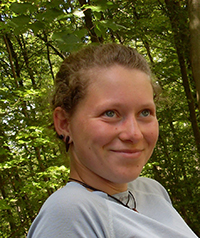 Karolin Moraweck. Senckenberg Natural History Collections Dresden, Königsbrücker Landstr. 159, 01109 Dresden, Germany. karolin.moraweck@senckenberg.de
Karolin Moraweck. Senckenberg Natural History Collections Dresden, Königsbrücker Landstr. 159, 01109 Dresden, Germany. karolin.moraweck@senckenberg.de
Karolin Moraweck got a diploma in Geography/Geology/Biology at the Technical University of Dresden and is currently finishing her phD in paleobotany at the Technical University of Dresden and the Senckenberg Natural History Collections Dresden. Her research focuses on the vegetational response correlated to paleoclimate and paleoatmospheric changes during the Paleogene/Neogene in central Europe.

 Jörg Lange. State Museum of Natural History, Rosenstein 1, 70191 Stuttgart, Germany. joerg.lange@smns-bw.de
Jörg Lange. State Museum of Natural History, Rosenstein 1, 70191 Stuttgart, Germany. joerg.lange@smns-bw.de
Jörg Lange works on projects of Bioinformatics and Biodiversity at the Museum for Natural History in Stuttgart.
Jörg Lange received a Ph.D. in Biophysics at the Georg-August-University of Göttingen, Germany. During stays at the Max-Planck-Institute for Biophysical Chemistry, the University of Southern California and the Max-Planck-Institute for Molecular Genetics he developed towards a Life Science programmer. He pursued a long term career as Computational Biologist at the company Novartis, Basel, Switzerland.

 Jiří Kvaček. National Museum Prague, Václavské náměsti 68, 115 79 Prague 1, Czech Republic. jiri.kvacek@nm.cz
Jiří Kvaček. National Museum Prague, Václavské náměsti 68, 115 79 Prague 1, Czech Republic. jiri.kvacek@nm.cz
Jiří Kvaček works 30 years on Cenophytic plant mega- and meso-fossils from Europe.

 Christoph Neinhuis. Technische Universität Dresden, Institute for Botany, Zellescher Weg 20b, 01217 Dresden, Germany. christoph.neinhuis@tu-dresden.de
Christoph Neinhuis. Technische Universität Dresden, Institute for Botany, Zellescher Weg 20b, 01217 Dresden, Germany. christoph.neinhuis@tu-dresden.de
Christoph Neinhuis holds the chair for botany at TU Dresden. He is also director of the Botanical Garden, and appointed Speaker of the Department of Biology. Research interests cover plant biodiversity, especially systematics and phylogeny of Aristolochiaceae and Piperaceae as well as biomechanics and functional morphology. Long lasting research interest counted for non-wettable and self-cleaning biomimetic surfaces and fiber-based plant structures and their potential for composites in engineering.

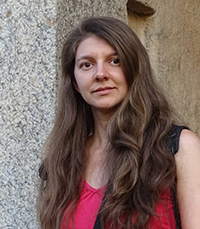 Annelise Folie. Royal Belgian Institute of Natural Sciences, rue Vautier 29, 1000 Brussels, Belgium. afolie@naturalsciences.be
Annelise Folie. Royal Belgian Institute of Natural Sciences, rue Vautier 29, 1000 Brussels, Belgium. afolie@naturalsciences.be
Annelise Folie did her undergraduate studies at the University of Namur and got her M.Sc. in Geology and Ph.D. in Paleontology at the University of Brussels in 2006. Since 2007, she is responsible for the Paleontogy Collections at the Royal Belgian Institute of Natural Sciences, Brussels, where she became curator in 2012. Her main research interest is on Paleogene herpetofaunas and ecosystems.

 Dario De Franceschi. CR2P-Sorbonne-Universités, CP38, 57 rue Cuvier, 75231 Paris, France. dario.de-franceschi@mnhn.fr
Dario De Franceschi. CR2P-Sorbonne-Universités, CP38, 57 rue Cuvier, 75231 Paris, France. dario.de-franceschi@mnhn.fr
Dario De Franceschi works on Cenozoic macrofossils and paleoenvironment.

 Andreas Kroh. Naturhistorisches Museum Wien, Burgring 7, 1010 Vienna, Austria. andreas.kroh@nhm-wien.ac.at
Andreas Kroh. Naturhistorisches Museum Wien, Burgring 7, 1010 Vienna, Austria. andreas.kroh@nhm-wien.ac.at
Andreas Kroh is a researcher and curator at the Natural History Museum in Vienna, Austria. His main research interests are echinoderms, with focus on the phylogeny, nomenclature and systematics of echinoids. Being a paleontologist with a strong interest in bridging the gap between life and earth sciences, he is actively involved in various efforts to ease access to biodiversity and taxonomic data on echinoids. He is involved in two database projects working towards this goal: the World Echinoidea Database (marinespecies.org/echinoidea) and the Echinoid Directory (www.nhm.ac.uk/research-curation/research/projects/echinoid-directory).

 Cyrille Prestianni. Royal Belgian Institute of Natural Sciences, rue Vautier 29, 1000 Brussels, Belgium. cprestianni@naturalsciences.be
Cyrille Prestianni. Royal Belgian Institute of Natural Sciences, rue Vautier 29, 1000 Brussels, Belgium. cprestianni@naturalsciences.be
Cyrille Prestianni works at the Royal Belgian Institute of Natural Sciences, Brussels. His research is focused on Paleozoic floras and faunas.

 Markus Poschmann. Generaldirektion Kulturelles Erbe RLP, Direktion Landesarchäologie / Erdgeschichte, Niederberger Höhe 1, 56077 Koblenz, Germany. markus.poschmann@gdke.rlp.de
Markus Poschmann. Generaldirektion Kulturelles Erbe RLP, Direktion Landesarchäologie / Erdgeschichte, Niederberger Höhe 1, 56077 Koblenz, Germany. markus.poschmann@gdke.rlp.de
Markus Poschmann is conducting palaeontological excavations in Rhineland-Palatinate and is an expert on fossil chelicerate arthropods.

 Michael Wuttke. Senckenberg Research Institute, Senckenberganlage 25, 60325 Frankfurt am Main, Germany. michael.wuttke@senckenberg.de
Michael Wuttke. Senckenberg Research Institute, Senckenberganlage 25, 60325 Frankfurt am Main, Germany. michael.wuttke@senckenberg.de
Michael Wuttke got a PhD in vertebrate palaeontology at the Johannes Gutenberg University Mainz. He is volunteer in the Department of Messel Research and Mammology at the Senckenberg Research Institute Frankfurt/M. His research focus is on the evolution and biology of Paleogene frogs in central Europe, and in palaeolimnological research of volcanogenic lakes.
APPENDIX 1
Web page of the MORPHYLL database http://www.morphyll.naturkundemuseum-bw.de (Traiser et al., 2015).
TABLE 1. Summary of specimen included in MORPHYLL until now. 1Location number as in Figure 1. 2Museums: GDKE: Generaldirektion Kulturelles Erbe Rheinland-Pfalz, Mainz. MfN: Museum für Naturkunde, Berlin. MMG: Museum of Mineralogy and Geology, Dresden. MNHN: Muséum National d'Histoire Naturelle, Paris. NHM: Natural History Museum, Vienna. NMP: National Museum Prague. RBINS: Royal Belgian Institute of Natural Science, Brussels. SMNS: State Museum of Natural History, Stuttgart. 3The fossil site “Rauenberg” is also known as “Frauenweiler”.
| Location number1 | Number of specimens | Fossil site [Country] |
Age | Epoch | Institution2 and City |
| 1 | 54 | Eferding [Austria] | Egerian | Miocene | NHM, Vienna [Austria] |
| 2a | 13 | Linz-Ebelsberg [Austria] | Aquitanian | Miocene | NHM, Vienna [Austria] |
| 2b | 87 | Linz-Pucking [Austria] | Aquitanian | Miocene | NHM, Vienna [Austria] |
| 2c | 42 | Linz-Weikerlsee [Austria] | Aquitanian | Miocene | NHM, Vienna [Austria] |
| 3 | 30 | Borna-Ost/Bockwitz [Germany] | Chattian | Oligocene | MMG, Dresden [Germany] |
| 4 | 417 | Enspel [Germany] | Chattian | Oligocene | GDKE, Mainz [Germany] |
| 5 | 331 | Kleinsaubernitz [Germany] | Chattian | Oligocene | MMG, Dresden [Germany] |
| 6 | 27 | Rott [Germany] | Chattian | Oligocene | RBINS, Brussels [Belgium] |
| 7 | 26 | Witznitz [Germany] | Chattian | Oligocene | MMG, Dresden [Germany] |
| 8 | 217 | Rauenberg3 [Germany] | Rupelian | Oligocene | SMNS, Stuttgart [Germany] |
| 9 | 259 | Markvartice u Děčína [Czech Republic] | Rupelian | Oligocene | NMP, Prague [Czech Republic] |
| 10 | 114 | Schleenhain [Germany] | Rupelian | Oligocene | MMG, Dresden [Germany] |
| 11 | 254 | Seifhennersdorf [Germany] | Rupelian | Oligocene | MMG, Dresden [Germany] |
| 12 | 150 | Klausa [Germany] | Priabonian | Eocene | MMG, Dresden [Germany] |
| 13 | 2 | Knau [Germany] | Priabonian | Eocene | MMG, Dresden [Germany] |
| 14 | 1079 | Kučlín [Czech Republic] | Priabonian | Eocene | NMP, Prague [Czech Republic] |
| 15 | 4 | Peres [Germany] | Priabonian | Eocene | MMG, Dresden [Germany] |
| 16 | 32 | Staré Sedlo [Czech Republic] | Priabonian | Eocene | NHM, Vienna [Austria] |
| 17 | 236 | Svatava - Na Pískách [Czech Republic] | Priabonian | Eocene | NMP, Prague [Czech Republic] |
| 18 | 48 | Profen [Germany] | Baronian | Eocene | MMG, Dresden [Germany] |
| 19 | 1090 | Geiseltal [Germany] | Lutetian | Eocene | MfN, Berlin [Germany] |
| 20a | 217 | Sézanne [France] | Thanetian | Paleocene | MNHN, Paris [France] |
| 20b | 32 | Sézanne [France] | Thanetian | Paleocene | NHM, Vienna [Austria] |
| 20c | 28 | Sézanne [France] | Thanetian | Paleocene | RBINS, Brussels [Belgium] |
| 21a | 39 | Gelinden [Belgium] | Selandian | Paleocene | NHM, Vienna [Austria] |
| 21b | 488 | Gelinden [Belgium] | Selandian | Paleocene | RBINS, Brussels [Belgium] |
| 22 | 586 | Menat [France] | Selandian | Paleocene | MNHN, Paris [France] |
TABLE 2. List of parameters stored in MORPHYLL. Parameters marked with an asterisk are included in the query mask (partially upon registration). Morphological traits used as defined by Ellis et al. (2009). Parameter without an asterisk can be obtained directly from the curator (see main text).
| Meta data | Taxonomic data | Qualitative data | Quantitative data | Geometry data (Shapefiles) |
| Specimen accession number* | Taxon (species)* | Leaf margin type* | Lamina area [mm2]* | Lamina outline (polygon) |
| Name of institution* | Genus* | Leaf lobation type* | Lamina perimeter [mm] | Petiole length (linestring) |
| Name of fossil site* | Family* | Leaf shape type | Lamina length [mm]* | Petiole width (linestring) |
| Country of fossil site* | Order* | Leaf size class* | Lamina width [mm]* | Primary veins (multilinestrings) |
| Stratigraphic age* | Primary vein architecture type* | Lamina length-to-width ratio [-]* | Secondary veins (multilinestrings) | |
| Stratigraphic epoch* | Secondary vein architecture type* | Lamina circularity [-] | Tertiary veins (multilinestrings) | |
| Petiole preservation* | Lamina centroid [%] | |||
| Area index [-]* | ||||
| Petiole length [mm]* | ||||
| Petiole width [mm]* | ||||
| Leaf mass per area [g/m2] |
MORPHYLL: A database of fossil leaves and their morphological traits
Plain Language Abstract
The size and shape of fossil leaves provide important information for reconstructing climate and environment of the past. Considering the importance of fossil leaf traits in palaeoclimatology and palaeoecology, there is a high demand for readily available data. In this contribution, the newly erected database MORPHYLL is described, which provides quantitative and qualitative leaf trait data compiled from various fossil leaf collections, mainly from the Paleogene (66-23 million years before present), thus offering a new web resource for palaeontological research. The collections are stored in various European natural history museums. Some exemplary analyses of leaf traits through time are shown to illustrate the analytical potential of the database.
Resumen en Español
MORPHYLL - una base de datos de hojas fósiles y sus rasgos morfológicos
Los caracteres morfométricos de las hojas fósiles, como el tamaño y la forma, son fuentes de datos importantes y ampliamente utilizadas para la reconstrucción de los paleoambientes. Varias herramientas, incluyendo CLAMP o Análisis del Margen de Hoja (Leaf Margin Analysis), utilizan los rasgos de la hoja como parámetros de entrada para estimar el paleoclima, principalmente teniendo en consideración las correlaciones entre los rasgos de las plantas actuales y los parámetros climáticos actuales. Durante los últimos años, el alcance de la información extraída de la morfología de las hojas fósiles se ha ampliado aún más al incluir la eficiencia de las hojas, que describe las correlaciones entre los rasgos funcionales de las hojas y las estrategias ecológicas. La cantidad y calidad de los datos disponibles son esenciales para un análisis paleoecológico adecuado utilizando los rasgos de las hojas. Se describe aquí la base de datos MORPHYLL. Esta base de datos está diseñada para ofrecer un recurso disponible en internet para conjuntos de datos de rasgos de hojas fósiles. Para este propósito, se digitalizaron las hojas fósiles de varias colecciones y se obtuvieron los rasgos morfométricos de los contornos de las hojas. Además de los metadatos, como la sigla para cada ejemplar, la colección en la que se encuentra depositado, el yacimiento del que procede o la información taxonómica (para especímenes identificados), MORPHYLL ofrece consultas para varios parámetros morfométricos y rasgos ecofisiológicos derivados (por ejemplo, masa foliar por área). Actualmente, la base de datos contiene datos de alrededor de 6000 hojas fósiles de yacimientos de Europa Central, abarcando casi todo el Paleógeno y parte del Neógeno temprano. El potencial de aplicación de la base de datos se demuestra mediante la realización de algunos análisis a modo de ejemplo de rasgos foliares para el Paleoceno, el Eoceno y el Oligoceno, de manera que se puede observar cómo cambiaron los rasgos medios de las hojas a lo largo del tiempo. Por ejemplo, los resultados muestran que la masa foliar por área alcanza su máximo durante el Eoceno, lo cual está de acuerdo con los cambios generales del clima durante el Paleógeno.
Palabras clave: base de datos de hojas; hojas fósiles; rasgos de la hoja; morfometría de la hoja; Paleógeno; Europa Central
Traducción: Enrique Peñalver (Sociedad Española de Paleontología)
Résumé en Français
MORPHYLL - une base de données de feuilles fossiles et de leurs traits morphologiques
Les caractères morphométriques des feuilles fossiles, tels que la taille et la forme, sont des sources de données importantes et fréquemment utilisées pour reconstruire les paléoenvironnements. Divers outils, notamment CLAMP ou l’Analyse du Bord des Feuilles (« Leaf Margin Analysis »), utilisent les traits des feuilles comme des paramètres d’entrée pour estimer le paléoclimat, en se basant principalement sur des corrélations entre ces traits et des paramètres climatiques chez les plantes actuelles. Ces dernières années, le périmètre des informations extraites de la morphologie des feuilles fossiles a été étendu en incluant l’écophysiologie des feuilles qui décrit les corrélations entre des traits fonctionnels des feuilles et des stratégies écologiques. La quantité et la qualité des données disponibles sont cruciales pour que les analyses paléoécologiques utilisant les traits des feuilles soient fructueuses. Nous décrivons dans cet article la base de données MORPHYLL. Cette base de données est conçue pour offrir une ressource en ligne pour les données de traits des feuilles fossiles. Dans ce but, des feuilles fossiles de plusieurs collections ont été numérisées et des traits morphométriques ont été extraits des contours des feuilles. En plus des métadonnées telles que le numéro de spécimen, la collection, le site fossile, ou les informations taxinomiques (pour les spécimens identifiés), MORPHYLL offre la possibilité d’effectuer des requêtes pour plusieurs paramètres morphométriques, et des traits écophysiologiques en dérivant (par exemple, la masse de feuilles par unité de surface). Actuellement, la base contient des données pour environ 6000 feuilles fossiles de sites d’Europe centrale, couvrant presque tout le Paléogène et une partie du Néogène ancien. L’application potentielle de cette base de données est démontrée en effectuant quelques exemples d’analyses des traits de feuilles pour le Paléocène, l’Éocène, et l’Oligocène, avec des résultats indiquant des changements des traits moyens des feuilles au cours du temps. Par exemple, les résultats montrent que la masse de feuilles par unité de surface atteint son point le plus haut pendant l’Éocène, ce qui est congruent avec le développement général du climat pendant le Paléogène.
Mots-clés : base de données de feuilles ; feuilles fossiles ; traits des feuilles ; morphométrie des feuilles ; Paléogène ; Europe centrale
Translator: Antoine Souron
Deutsche Zusammenfassung
MORPHYLL – Datenbank für fossile Blätter und ihre morphologischen Merkmale
Morphometrische Merkmale fossiler Blätter wie z.B. Blattgröße und -form stellen wichtige und oft benutzte Proxies für die Rekonstruktion von Paläo-Umweltbedingungen dar. Zahlreiche Methoden zur Paläoklimarekonstruktion, wie CLAMP und die Blattrandanalyse, basieren auf Blattmerkmalen und deren (rezente) Korrelationen mit klimatischen Parametern. In den letzten Jahren hat sich die Bandbreite von Informationen, die aus morphologischen Merkmalen fossiler Blätter gewonnen werden können, zusätzlich auf blattökonomische Parameter ausgeweitet, die Aufschluss über grundlegende ökologischen Strategien geben können. Der Umfang und die Qualität der für solche Ansätze verfügbaren Daten ist maßgebend für eine erfolgreiche paläoökologische Analyse. In dieser Studie wird die Datenbank MORPHYLL vorgestellt, die als eine webbasierte Ressource für fossile Blattmerkmale konzipiert wurde. Hierfür wurden fossile Blätter aus verschiedenen Sammlungen europäischer Museen digitalisiert und morphologische Merkmale aus den Blattumrissen extrahiert. Neben den Metadaten der Fossilien, wie z.B. Akzessionsnummer, Aufbewahrungsort, fossile Lokalität und taxonomische Informationen (soweit vorhanden), bietet MORPHYLL Abfragemöglichkeiten für zahlreiche morphometrische Parameter und daraus abgeleitete ökophysiologische Merkmale (z.B. Blattmasse pro Blattfläche). Momentan enthält die Datenbank Informationen zu ca. 6000 Blattfossilien verschiedener zentral-europäischer Fundstellen, die das gesamte Paläogen und das frühe Neogen umfassen. Das Potenzial der Datenbank wird anhand von einigen exemplarischen Analysen blattmorphometrischer Merkmale für das Paläozän, Eozän und Oligozän demonstriert, die auf deutliche Veränderungen der mittleren Blattmerkmalsausprägungen im Verlauf der Zeit hinweisen. So zeigt z.B. die mittlere Blattmasse pro Blattfläche einen deutlichen Höhepunkt während des Eozäns, was mit der generellen klimatischen Entwicklung während des Paläogens gut übereinstimmt.
Schlagworte: Blattdatenbank; fossile Blätter, Blattmerkmale; Blattmorphometrie; Paläogen; Zentral-Europa
Translator: Author
Arabic
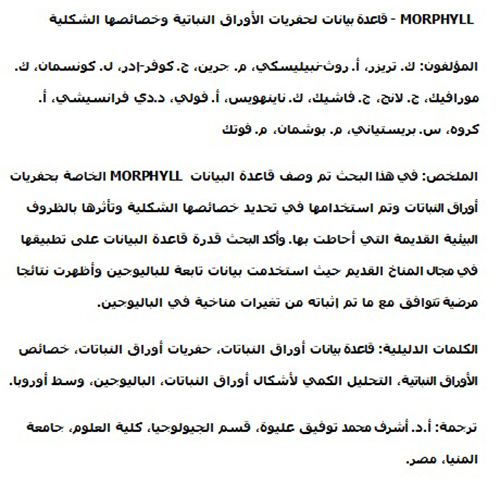
Translator: Ashraf M.T. Elewa
-
PE: An influential journal
 Palaeontologia Electronica among the most influential palaeontological journals
Palaeontologia Electronica among the most influential palaeontological journalsArticle number: 27.2.2E
July 2024 -



 A Review of Handbook of Paleoichthyology Volume 8a: Actinopterygii I, Palaeoniscimorpha, Stem Neopterygii, Chondrostei
A Review of Handbook of Paleoichthyology Volume 8a: Actinopterygii I, Palaeoniscimorpha, Stem Neopterygii, Chondrostei